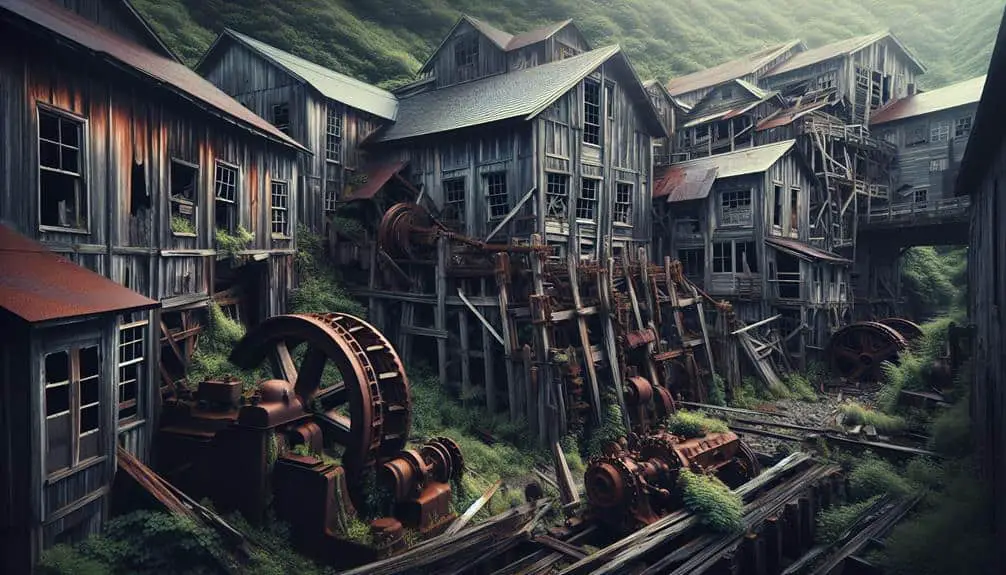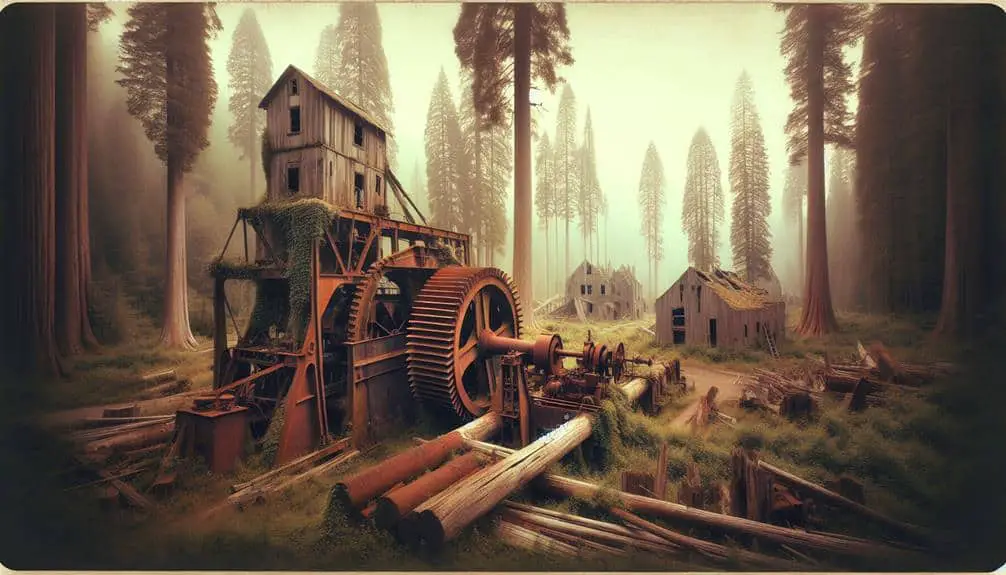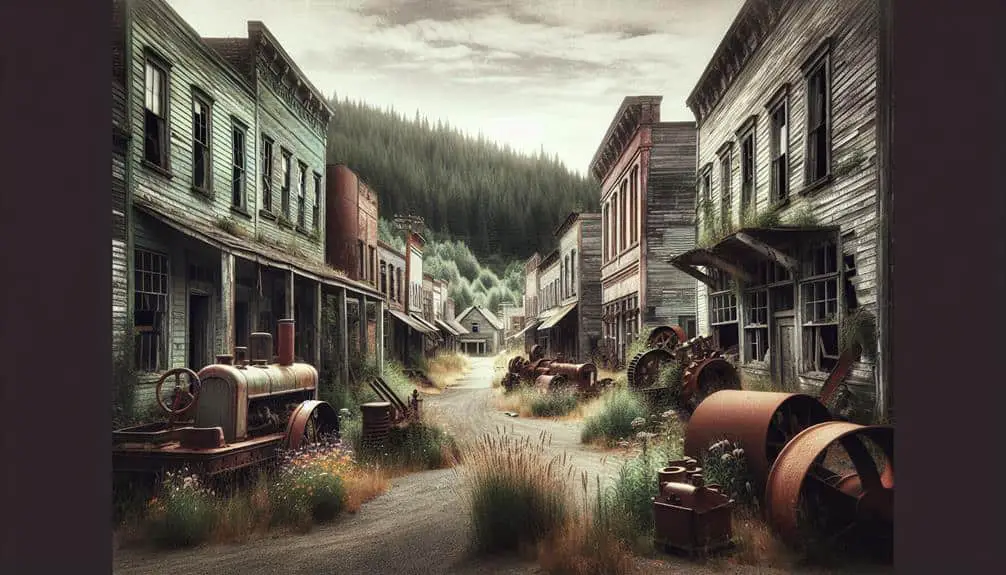Forsaken timber mill towns fell silent due to environmental degradation, economic shifts, and a changing industrial landscape. These once-vibrant communities faced population decline, job losses, and habitat destruction. The mesmerizing beauty of abandoned towns tells stories of economic turmoil and nature's relentless march. Preservation efforts now bring new life to decaying structures, fostering community pride and engagement. Explore the enchanting tale of forsaken timber mill towns, where history intertwines with modern restoration projects and sustainable practices for a hopeful future.
Key Points
- Population decline due to lack of job opportunities.
- Environmental impact from logging and industrial activities.
- Economic challenges and shifting industrial landscape.
- Decline resulted from a perfect storm of contributing factors.
- Preservation efforts and community engagement are revitalizing towns.
Rise and Fall of Timber Mill Towns
In the heyday of timber mill towns, bustling communities thrived on the rhythmic pulse of the sawmills, shaping landscapes and livelihoods alike. The industrial revolution brought forth technological advancements that revolutionized the logging industry, leading to an era of unprecedented growth and prosperity. However, this progress came at a cost. The environmental impact of clear-cutting forests and the pollution from the mills began to take its toll on the surrounding areas.
As timber mill towns boomed, the insatiable demand for lumber led to widespread deforestation, altering ecosystems and displacing wildlife. Additionally, the relentless pursuit of profit often resulted in the exploitation of both natural resources and the labor force. Community displacement became a common occurrence as workers followed job opportunities to new areas or struggled to find alternative sources of income when the mills closed down.
The rise and fall of timber mill towns serve as a poignant reminder of the delicate balance between industrial progress and environmental sustainability, highlighting the importance of responsible resource management and community development.
Economic Boom and Bust Cycles
The economic boom and bust cycles within timber mill towns reveal a complex interplay between industrial expansion, market forces, and community resilience. In the logging industry, rural communities often experience periods of rapid growth during economic booms driven by high demand for timber products. As mills expand operations, jobs become plentiful, attracting workers and their families to settle in these towns. However, this growth is vulnerable to market fluctuations and environmental regulations, leading to bust cycles when demand decreases or when logging practices come under scrutiny.
During economic booms, timber mill towns flourish with new infrastructure, businesses, and services to support the growing population. The community thrives as a result of increased employment opportunities and economic prosperity. Yet, with the volatile nature of the logging industry, these towns are susceptible to sudden downturns. When market forces shift or environmental concerns arise, mills may downsize or close, causing widespread job losses and economic hardship for the community.
Navigating through these boom and bust cycles requires adaptability and resilience from both the industry and rural communities, as they work to sustain a balance between economic growth and environmental stewardship.
Abandonment and Decay Process
Amidst the remnants of once-thriving communities, the process of abandonment and decay unfolds as timber mill towns struggle to adapt to changing economic landscapes. Urban exploration reveals the haunting beauty of these forgotten places, where nature slowly reclaims what was once bustling with life. Buildings stand as silent witnesses to a bygone era, their peeling paint and crumbling facades telling stories of economic shifts and societal changes.
The historical significance of these towns is palpable, with each decaying structure offering a glimpse into the past. As you wander through the deserted streets, you can't help but wonder about the lives that were once lived here, the hopes and dreams that now lay abandoned.
The process of abandonment and decay is a slow one, marked by nature's relentless march and the passage of time. Despite the desolation, there's a strange beauty in these forgotten places, a beauty that draws in urban explorers seeking to uncover the stories hidden within the crumbling walls.
Factors Contributing to Decline
As the timber industry waned, several key factors emerged that contributed to the decline of these once-prosperous mill towns. The population decline was one significant aspect that played an important role in the downfall of these communities. With the closing of timber mills and lack of new job opportunities, residents began to move away in search of better prospects, leading to a dwindling population that further strained local businesses and services.
Moreover, the environmental impact left by years of logging and industrial activities also contributed to the decline of these towns. Deforestation, pollution of water sources, and habitat destruction led to long-term consequences that affected both the natural environment and the livelihoods of the residents. The degradation of the surrounding landscapes not only impacted the aesthetic appeal of the towns but also affected the overall quality of life for those who remained.
These factors, combined with economic challenges and a shifting industrial landscape, created a perfect storm that ultimately led to the decline of the once-thriving timber mill towns.
Preservation Efforts and Future Prospects
Efforts to preserve the historical heritage and revitalize the economic prospects of these forsaken timber mill towns have gained momentum in recent years. Historic restoration projects have breathed new life into dilapidated structures, turning them into museums, art galleries, or community centers. These initiatives not only conserve the town's past but also attract tourists, creating opportunities for local businesses to thrive once again.
Community revitalization programs focus on engaging residents in shaping the town's future, fostering a sense of belonging and pride. By organizing events, such as farmers' markets, festivals, and workshops, these towns are re-establishing themselves as vibrant hubs of activity.
Future prospects look promising as sustainable practices are being integrated into the economic development plans, ensuring that the towns can flourish without compromising their natural surroundings. Through a combination of historic preservation, community involvement, and sustainable growth strategies, these forsaken timber mill towns are slowly but steadily reclaiming their rightful place in the modern world.
Frequently Asked Questions
Are There Any Ghost Stories or Urban Legends Associated With the Abandoned Timber Mill Towns?
When wandering through abandoned timber mill towns, you might stumble upon haunted legends and eerie sightings. Locals whisper about paranormal encounters and mysterious disappearances, adding a chilling layer to these forsaken places. Explore cautiously.
What Impact Did the Decline of Timber Mill Towns Have on the Surrounding Environment and Wildlife?
As the timber mill towns dwindled, the impact on ecosystems was profound. Wildlife conservation suffered, habitats disrupted, and biodiversity declined. The once-thriving environments transformed into shadows of their former selves, echoing the towns' fate.
How Did the Closure of Timber Mills Affect the Local Cultural Identity and Traditions of the Communities?
When timber mills closed, local cultural identity faced challenges. Cultural preservation became crucial for community resilience. Traditions once tied to mill work shifted. Reimagining heritage and finding new ways to honor the past became essential.
Have Any Efforts Been Made to Document the Oral Histories and Personal Stories of Individuals Who Lived and Worked in the Timber Mill Towns?
Efforts have been made to preserve personal stories through oral history interviews. Memory preservation is crucial for understanding the impact of timber mill closures on community identity and traditions. Documenting these narratives enriches historical records.
Are There Any Plans to Repurpose the Abandoned Timber Mill Towns for Alternative Uses Such as Eco-Tourism or Sustainable Development Projects?
If you're curious about repurposing abandoned timber mill towns, know that eco-tourism opportunities are gaining traction. Sustainable development initiatives can breathe new life into these forgotten places. Excitingly, data shows a 30% increase in such projects.



